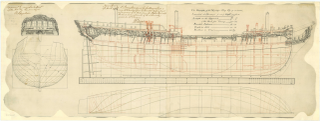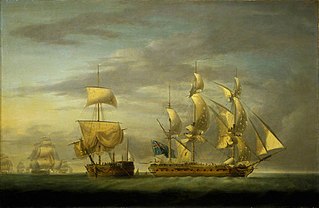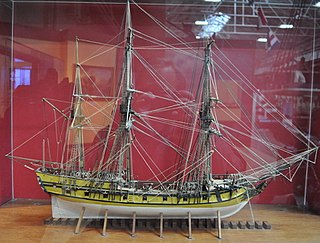
HMS Minerva was a 38-gun fifth-rate Royal Navy frigate. The first of four Minerva-class frigates, she was launched on 3 June 1780, and commissioned soon thereafter. In 1798 she was renamed Pallas and employed as a troopship. She was broken up in 1803.

HMS Magnanime was a 64-gun third-rate ship of the line of the Royal Navy, launched on 14 October 1780 at Deptford Dockyard. She belonged to the Intrepid-class designed by Sir John Williams and later was razeed into a 44 gun frigate.

HMS Fly was a Swan class ship sloop of the Royal Navy and was launched on 14 September 1776. She performed mainly convoy escort duties during the French Revolutionary Wars, though she did capture three privateers. She foundered and was lost with all hands early in 1802.
HMS Amphitrite was a 24-gun Porcupine-class sixth-rate post ship of the Royal Navy. She served during the American Revolution primarily in the economic war. On the one hand she protected the trade by capturing or assisting at the capture of a number of privateers, some of which the Royal Navy then took into service. On the other hand, she also captured many American merchant vessels, most of them small. Amphrite was wrecked early in 1794.

HMS Santa Margarita was a 36-gun fifth-rate frigate of the Royal Navy. She had been built for service with the Spanish Navy, but was captured after five years in service, eventually spending nearly 60 years with the British.

Sir Andrew Snape Douglas was a distinguished Scottish sea captain in the Royal Navy during the American War of Independence and French Revolutionary Wars.

HMS Castor was a 32-gun Amazon-class fifth-rate frigate of the Royal Navy. She served during the French Revolutionary and Napoleonic Wars. The French briefly captured her during the Atlantic Campaign of May 1794 but she spent just 20 days in French hands as a British ship retook her before her prize crew could reach a French port. Castor eventually saw service in many of the theatres of the wars, spending time in the waters off the British Isles, in the Mediterranean and Atlantic, as well as the Caribbean.

HMS Daedalus was a 32-gun fifth rate frigate of the Royal Navy, launched in 1780 from the yards of John Fisher, of Liverpool. She went on to serve in the American War of Independence, as well as the French Revolutionary and Napoleonic Wars.

HMS Carysfort was a 28-gun Coventry-class sixth-rate frigate of the Royal Navy. She served during the American War of Independence, the French Revolutionary and the Napoleonic Wars in a career that spanned over forty years.

The Speedy class brigs were a two-ship class of brig built for the Royal Navy during the later years of the American War of Independence. They survived into the French Revolutionary Wars.

John Bastard of Sharpham, Ashprington, Devon, was an officer of the Royal Navy who saw service during the French Revolutionary and Napoleonic Wars, and the War of 1812, rising to the rank of post-captain. He also entered politics and became a Member of Parliament.

HMS Surprise was a 28-gun Enterprise-class sixth-rate frigate of the Royal Navy, which served throughout the American Revolutionary War and was broken up in 1783.

HMS Medea was a 28-gun Enterprise-class sixth-rate frigate of the Royal Navy. Medea was first commissioned in May 1778 under the command of Captain William Cornwallis. She was sold for breaking up in 1805.
Robert Linzee was an officer of the Royal Navy who served during the American War of Independence, and the French Revolutionary and Napoleonic Wars.

Hon. Charles Phipps was an officer in the Royal Navy. He served during the American War of Independence, seeing action in a number of battles and engagements. He also went on to have a career in Parliament sitting in the House of Commons from 1779 to 1786.

HMS Sprightly was a 10-gun cutter of the Royal Navy, built to a design by John Williams, and the name ship of her two-vessel class of cutters. She was launched in 1778. The French captured and scuttled her off the Andulasian coast in 1801.

HMS Barbuda was commissioned into the Royal Navy in 1780 after having briefly served as an American privateer. Barbuda was one of the two sloops that captured Demerara and Essequibo in 1781, but the French Navy captured her there in 1782 and took her into service as Barboude. The French Navy sold her to private owners in 1786, and she served briefly as a privateer in early 1793 before the French Navy purchased her again and named her Légère. She served them until mid-1796 when the Royal Navy captured her and took her into service as HMS Legere. She was wrecked off the coast of Colombia, without loss of life, in February 1801.
The French brig Duc de Chartres was built between 1779 and 1780 at Le Havre as a 24-gun privateer. As a privateer she captured one British warship before in 1781 the Royal Navy captured her. The Royal Navy took her into service as HMS Duc de Chartres. She then captured several American privateers and armed merchant vessels, and one French naval corvette in a noteworthy single-ship action. The Navy sold Duc de Chartres in 1784.

HMS Cormorant was probably launched in 1780 at Plymouth, Massachusetts. She was commissioned as the Massachusetts privateer Rattlesnake in 1781. The Royal Navy captured her shortly after she set out on a cruise and purchased her. In November 1781 she carried to England the first news of General Cornwallis's defeat. The Royal Navy registered her under the name Cormorant. In 1783 the navy renamed her Rattlesnake. It paid her off and sold her in 1786.
HMS Mentor was the Massachusetts letter of marque Aurora, commissioned in 1780. The Royal Navy captured her in July 1781 and took her into service as HMS Mentor. Mentor disappeared in 1783.
This page is based on this
Wikipedia article Text is available under the
CC BY-SA 4.0 license; additional terms may apply.
Images, videos and audio are available under their respective licenses.















